The Making of a Dynasty, Part 1
Welcome, everyone, to the first preview week of Kamigawa: Neon Dynasty. Today, I'm going to introduce you to the Vision Design team, start telling you the story of the set's design, and show off two cool preview cards. I have plenty of stories to tell, so let's get to it.
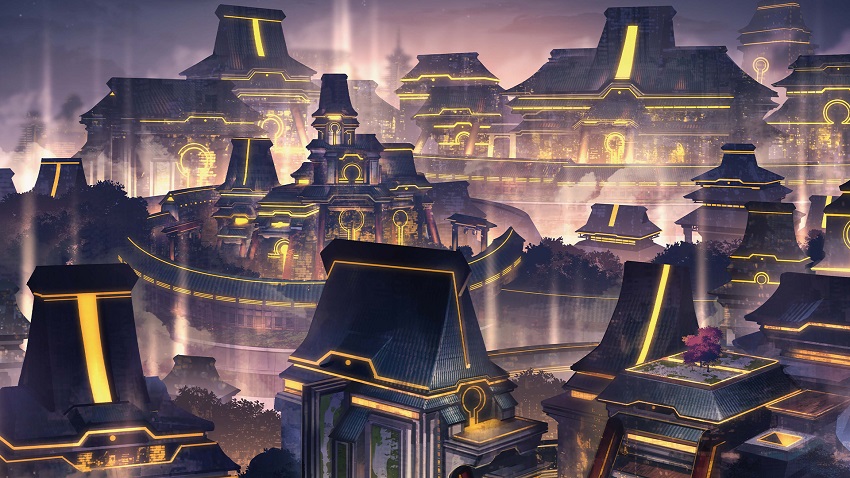
Names in Neon
Before I get to the story, I like to start by introducing you to the designers involved. Today, I'll be introducing the Exploratory and Vision Design teams (as I led both), and next week, Dave Humpherys will introduce you to the Set Design team.
Click below to meet the Exploratory and Vision Design teams of Kamigawa: Neon Dynasty.
Click here to meet the teams
Mark Rosewater (exploratory and vision design lead)
Some teams I'm asked to lead, and some teams I ask to lead. This was the latter. As you will see when I get to the story of the design, I was intent on returning to Kamigawa, but I knew that it was a bumpy road to get there, so it needed to be something I was leading personally. Assuming I'm not forgetting anything, Kamigawa: Neon Dynasty is my thirty-third time leading or co-leading the design of a Magic set.
Ari Nieh (strong second, vision design)
Besides being a great designer, Ari also lived in Japan for four years growing up and has a lot of knowledge about both Japanese historical culture and pop culture. She was the perfect choice to be my strong second for the set, both because the set has a lot of top-down elements and she brings so much to the table skill-wise. Ari would get the chance to lead her own vision design team for Brothers' War coming out later in the year. Ari was a wonderful strong second, adding a lot to the overall vision of the set.
Emily Teng (exploratory and vision design, creative liaison)
Emily oversaw worldbuilding from the creative side, so we had her on the team to make sure that the mechanics were lining up correctly with the plane. As you will see when we get to the design story, a lot happened during design, so it was great having her around. One of the things I enjoyed most about having Emily on the team was that she approached each design challenge through the lens of the world's philosophy so we could make sure the play of the set felt appropriate for the plane and story.
Chris Mooney (exploratory and vision design)
Chris is a very strong blue-sky designer, so it's always a treat having them on exploratory teams. They are a huge fan of Japanese pop culture and were a huge help early on, mapping out all the potential tropes we could work with. While Chris was only on the beginning of vision design, they'd keep popping their head into vision design (and I assume later set design) to see if the tropes they were most excited about were still in the set.
Daniel Holt (vision design)
There is no greater fan of the Kamigawa block in R&D than Daniel. When he heard we were doing a Japanese-themed set that may or may not be Kamigawa, he insisted that he work on the set. As I explained in my Innistrad: Crimson Vow write-up on Daniel, his main job is working on graphic design elements on the cards (mainly frames and symbols), but he loves doing design work when he gets the opportunity. Having a Kamigawa superfan on the team proved to be a huge bonus.
Dave Humpherys (vision design, set design lead)
When Dave leads a Set Design team, he also likes to be on the Vision Design team. I've worked with Dave many times before (War of the Spark and Ikoria: Lair of Behemoths being the two most recent), and we have a strong working relationship. Dave sits back and lets me craft the vision but always asks questions to make sure that we're considering issues he'll have to care about down the road.
David McDarby (vision design)
David normally works in the digital game department, but he loves doing card design, so he's always asking if we can find a spot for him. I was on the lookout for as many Japanese subject matter experts as I could, and he is well versed in Japanese pop culture (something we were trying to incorporate more of in the return to Kamigawa), so I asked David to join the Vision Design team. He was a firehose of ideas and card designs, so I'm happy he could be part of the team.
Ethan Fleischer (exploratory and vision design)
Ethan and I have been on a lot of design teams together, and I'm always happy to have him on a design team. Ethan enjoys studying whatever the source material is and always comes up with ideas and designs that no one else does. He also has a good eye for larger cohesion and structure, so he always asks thought-provoking questions in the meetings.
Mark Gottlieb (vision design)
I believe Mark is the best top-down designer in R&D. He has a special gift for figuring out how to get mechanics to combine in just the right way to evoke that thing that best defines the concept in question. As you will see, Kamigawa: Neon Dynasty had a lot of top-down challenges for us to solve, so I was glad to have Mark aboard.
Point of No Return
Our story starts back in 2002 with Bill Rose. At the time, Bill was both the vice president of R&D and the head designer of Magic. (That ended up being a little too much for him to focus on, so he went on to make me the head designer in 2003.) Ever since Bill had taken over as head designer with Invasion block, each block had a theme. Up until that point, the theme had always been mechanical (Invasion, multicolor; Odyssey, graveyard; Onslaught, tribal; Mirrodin, artifacts). With the new block, Bill was interested in trying something different. Instead of designing the mechanics and then adapting the creative to it, what if we did it in reverse? What if we started with the creative and then adapted the mechanics to it? This would be R&D's first stab at a top-down block (Arabian Nights was the first top-down set).
Bill was interested in starting with a real-world cultural influence, and we spent several months exploring different options. In the end, a Japanese-inspired set edged out an Egyptian-inspired one. Brady Dommermuth, the then creative director, and his creative team rose to the challenge, using Japanese mythology, especially elements of Shinto, to craft a brand-new Magic plane.
Being the first time we did a top-down design based on a new world, we made a lot of mistakes. We locked in the creative before the mechanics were done, which led to a lot of ham-fisted design and parasitic mechanics (i.e., things that only work with other cards in the same set). We chose a major theme, legendary matters, that wasn't woven properly into the set, so you could open a lot of booster packs without being aware of what it was. The creative itself was a little too faithful to an aspect of Japanese mythology that the majority of the audience wasn't familiar with, so to a majority of the audience it read less "Japanese" and more "quirky". All in all, while it was a cool plane, we didn't execute on it as well as we could have (and again, I want to stress that this was our first time doing this type of top-down block design).
The result is that the set didn't do well. Sales were down. Play numbers were down. It received the lowest numbers in market research, both mechanically and flavorfully, since we've started doing market research on sets. It was considered internally to be a huge flop. And that would have been the end of the story, but then Commander happened. The format put a spotlight on legendary creatures, and suddenly, Champion of Kamigawa block's legendary theme got a lot of attention. Remember, this was back in the day where there were a lot less legendary creatures per set. Also, Kamigawa had lovable elements that, with time, eventually found their audience.
For those who have never read my blog, it's called Blogatog and is on Tumblr. Every day, I answer questions from Magic players, and the site has a kind of ebb and flow to it where different subjects become the topic of conversation for the day. Certain themes come back over and over and have become almost an inside joke for the regulars on the blog. The biggest recurring theme was us returning to Kamigawa. I explained that it was a hard sell to my bosses, as the original set did so poorly on almost every metric, but as I learned with Contraptions, the more I say we can't do something, the more the audience wants to see it. In my heart, having talked to a lot of players over the years about it, I knew it was something we needed to do, but the path to get there was daunting. Today's story is about how we got from "absolutely not" to "let's do it!"
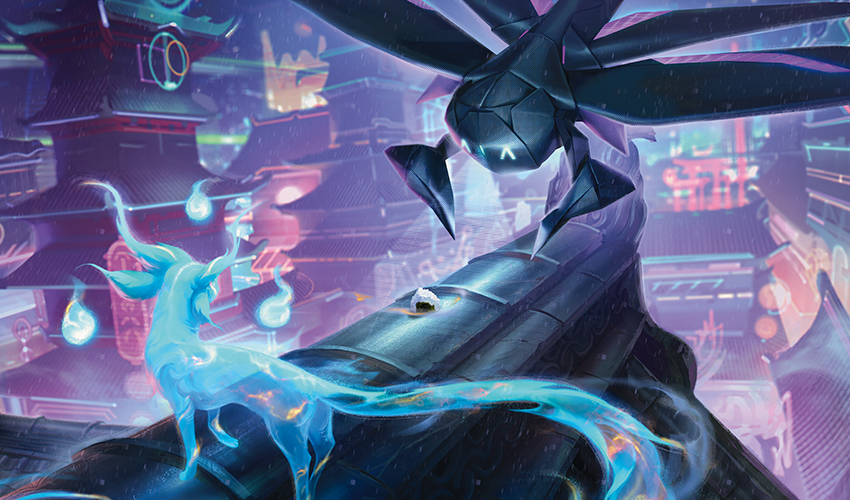
Once Again, With Feeling
Every couple of years, a bunch of upper-level people in R&D will get together and begin mapping out what the next handful of years is going to look like. What new planes should we visit? What old planes should we revisit? One of the ideas that's been floating around for years concerns us making a new Japanese-inspired plane. We had a cool idea for a more modern plane that could tap into a lot of the tropes of Japanese pop culture. The more we talked about the plane, the more excited people got. Finally, we decided to put it onto the schedule. I personally was interested in it because I believed this was my chance to get us to return to Kamigawa.
There were a lot of barriers in the way, though. This new idea was a big departure from original Kamigawa, and I still had to overcome all the internal reluctance to it being Kamigawa, but I had a whole exploratory and vision design to figure it out. The key to my plan began with the following statement I made to the rest of R&D: let's not worry about whether this plane is Kamigawa; let's just make the most awesome Japanese-inspired plane we can and we'll decide later whether to call it Kamigawa. (Remember, this new set occurred some 1,200 years later in the plane after the original Champions of Kamigawa block, so there was a built-in way to explain why the plane had changed a lot.)
Exploratory design started with the premise of us making the coolest Japanese-inspired plane we could. One of the things I was interested in was using tropes from Japanese pop culture in additional to historical and mythological influences. Through doing a lot of top-down designs, we'd learned that pop culture references have been more resonant to players than cultural ones, so we wanted to make sure we had a mix of both. In addition, we've started to get bolder with genre pushing in general, which allowed us to tap into cyberpunk tropes in a way we never could have during our first trip to Kamigawa. All of this led to a very cool new plane, but one that seemed very distant from original Kamigawa. Note that during exploratory design, Emily was leading the team doing exploratory worldbuilding, so we started to get a sense of what the plane would look and feel like.
When vision design began, I had a pretty good sense of what the new Japanese plane would look like. The big question for me: did that at all feel like Kamigawa? Yeah, we could call it Kamigawa, but the reason the players wanted a return wasn't to go to a plane that had no tie to the original. So, I went on my blog and asked what players would feel was necessary in a return. (For those unfamiliar with my blog, I ask questions all the time, so it's hard to tell what questions are specifically for a future project.) The answers were all over the board, but the one consistent answer was the races specific to Kamigawa (nezumi, soratami, etc.). Okay, what if we just made sure all those races were present? I talked with Emily, and the plans were to bring back most of them. It was a start, but I knew it wasn't enough.
The big breakthrough interestingly started when I asked a completely different question. Magic, at its core, is a game about magical conflict, so on any plane, there must be some core conflict present. Sometimes that conflict is front and center in the mechanics, and sometimes it's represented more in the flavor elements (art, names, flavor text). Because this was a Japanese-inspired set, I wanted to make sure that we had a theme that resonated from the source material. And that's when it all came together. You see, one of the big conflicts in Japan is a conflict between modernity and tradition. The culture embraces both the newest technology and ancient traditions, which creates an interesting conflict that runs through Japanese society and is reflected in its culture. What if that was the core conflict of the set?
The idea was that half the set could represent the new cyberpunk, pop culture-inspired plane we'd be making while the other half could play up ancient tradition. But not just any ancient tradition, a past that existed in Magic history. What if the second half of the set reflected Kamigawa as we'd seen it in Champions of Kamigawa block? What if we didn't have to choose between the option of new Japanese plane and old Japanese plane? What if the set was both and the core conflict was between them? That would mean this plane had to be Kamigawa, and we could have our cake and eat it too. All we had to do is mechanically represent the two sides in a way that felt opposite yet played well together. That's all.
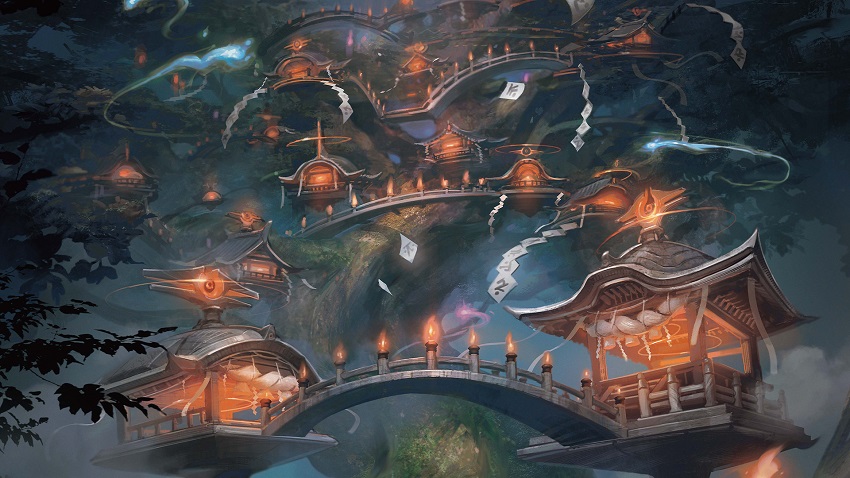
Just My Types
We solved this problem by looking at the two halves of the set first. In a vacuum, how would we represent each side? The modernity side seemed like the easier thing to solve. We've long used artifacts to represent technology, plus the newer plane made use of Equipment and Vehicles. It dawned on us that the old plane also had some use of artifacts, in the sense of objects from the distant past (the "antiquity" definition of artifact).
The problem was that simply using an artifact theme made the two sides feel too much the same and didn't create any sense of conflict. That's when we explored using enchantments for the traditional side of Kamigawa. Champions of Kamigawa block had several high-profile enchantments, including the Shrines and flip cards that turned into enchantments. Enchantments also captured a sense of natural magic and represented the past.
The best part about using enchantments is that it solved our puzzle. Artifacts and enchantments fulfill a similar mechanical role in the game but are flavorfully contrary to one another. They feel opposite but can be designed to play similarly. The modern side could use various types of artifacts. The traditional side could use various types of enchantments. The modern side could have artifact creatures. The traditional side could have enchantment creatures. The modern side could have Equipment. The traditional side could have Auras. We could create a parallel structure and use effects that cared about "artifacts or enchantments" when we wanted to mechanically care about each side.
We then decided to weigh each side toward certain colors. The modern side wanted to be blue. Blue cares the most about the future and has the greatest affinity for artifacts. The traditional side wanted to be green. Green cares most about the past and is one of the two biggest colors that cares about enchantments. We then made red secondary on the modern side, as it has a common artifact theme with blue, and white the secondary on the traditional side, as it has a common enchantment theme with green. We then put black in the middle as the color that is willing to use whatever resource necessary to get the job done. We even made a mechanic we called balance (it ended up getting printed without a name), a threshold ability where you need to control an artifact and an enchantment, centering it in black. Here's how the colors shook out:
Modernity < blue < red < black > white > green > Tradition
As we started evolving this idea, we worked closely with Emily and the worldbuilding team to make sure that this conflict was properly woven into the plane and adjusted based on our color weighting. Once the worldbuilding team was on board, I went to the rest of R&D with my pitch for why this plane had to be Kamigawa. Yes, we could make up a brand-new plane where we invented a past for it, but none of that would have nearly the weight of a plane we'd already visited where those things from Magic's past were part of that plane's past. Everyone saw the logic of the pitch, and the plane was officially signed off as Kamigawa about a month before Vision Design had to hand off to Set Design.
How did we figure out which elements of Kamigawa to keep and which to redo? I'll talk about all that and more next week.
Before I go, I will tell you about one mechanic that's coming back, because it's on today's preview cards. That mechanic is ninjutsu. I designed it during Champions of Kamigawa block as a top-down design to capture the feel of Ninjas. It was a popular mechanic from original Champions of Kamigawa block (and there's not a lot of those—more on that next week). It came back twice, once in Planechase 2012 and once in the first Modern Horizons. How could we bring back Ninjas without ninjutsu?
Click here to meet Covert Technician and Biting-Palm Ninja

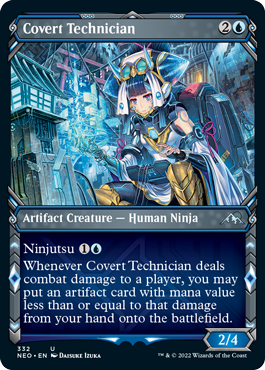
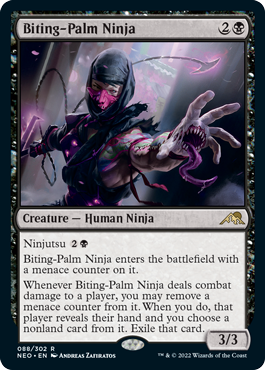

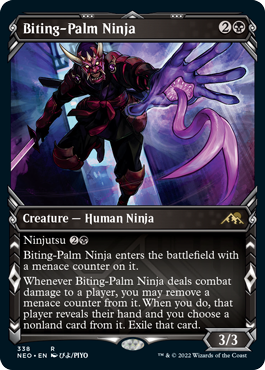
That's all the time I have for today. I hope you enjoyed hearing the beginning of Kamigawa: Neon Dynasty's design. As always, I'm eager to hear your feedback on today's column, today's preview card, or on the set Kamigawa: Neon Dynasty itself. You can email me or contact me through any of my social media accounts (Twitter, Tumblr, Instagram, and TikTok).
Join me next week as I continue the story of Kamigawa: Neon Dynasty's design.
Until then, may you enjoy the return to Kamigawa.
#899: Templating with Matt Tabak
#899: Templating with Matt Tabak
37:15
I sit down with Editor Matt Tabak to talk about the importance of templating.
#900: R&D Vocabulary, Part 4
#900: R&D Vocabulary, Part 4
31:26
This podcast is another in my series on R&D lingo.
- Episode 898 2017
- Episode 897 Rise of Eldrazi with Brian Tinsman
- Episode 896 Urza's Cards

